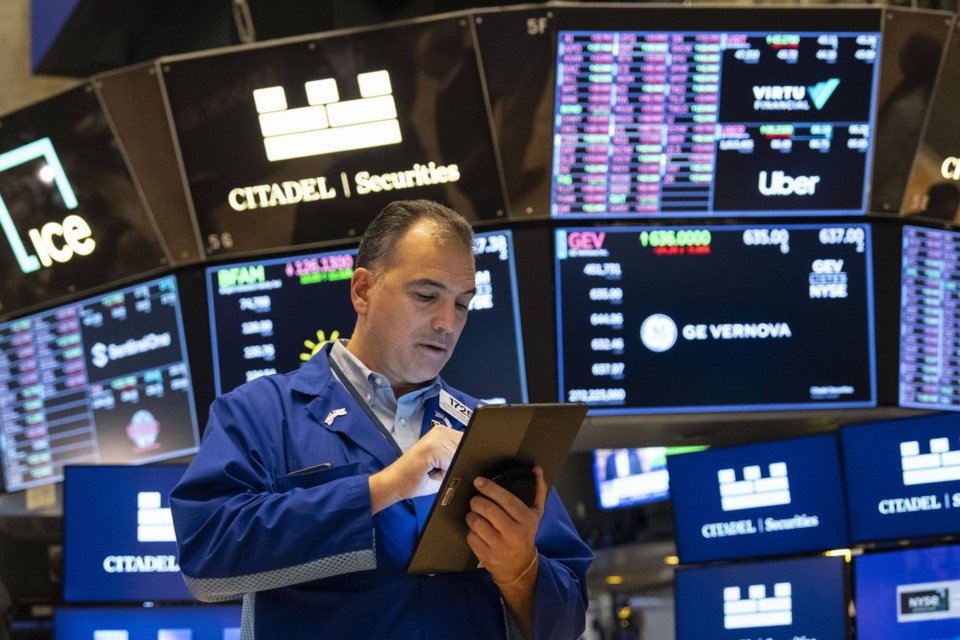NEW YORK (AP) — Wall Street is holding steadier following its see-saw ride that bracketed the weekend. The S&P 500 was up 0.1% in early trading Tuesday. The index is coming off its best day since May, which followed its worst day since May. The Dow Jones Industrial Average was edging up 27 points, and the Nasdaq composite was flat. Worries are still high that President Donald Trump’s tariffs may be hurting the economy. But increased hopes for cuts to interest rates by the Federal Reserve, along with a stream of stronger-than-expected profit reports from U.S. companies, are helping to support the market.
THIS IS A BREAKING NEWS UPDATE. AP’s earlier story follows below.
Wall Street headed higher in early trading Tuesday as markets' anxiety over last week's poor jobs data appears to have dissipated as investors turn their attention to another batch of corporate earnings.
Futures for the S&P 500 gained 0.3% before the bell, while Nasdaq futures climbed 0.4%. Futures for the Dow Jones Industrial Average were effectively unchanged.
Palantir Technologies is heading toward another record high after booking its first $1 billion in quarterly sales and raising its outlook for the year. Shares surged more than 6% to $170 before markets opened, which would be tops for the company that has already notched record highs four times this year. One year ago, Palantir shares were going for about $24 each.
Shares of Caterpillar fell 3.5% in premarket after the farming and industrial equipment maker's second-quarter profit fell short of Wall Street targets. The Texas company's operating profit in the period fell 18% from last year, which company executives blamed on "unfavorable manufacturing costs" related to higher tariffs.
Coming later this week are earnings reports from The Walt Disney Co., McDonald’s and DoorDash, along with updates on U.S. business activity.
Investors appeared to have recovered some confidence after worries over how President Donald Trump’s tariffs may be punishing the economy sent a shudder through Wall Street last week.
Reports from big U.S. companies have largely come in better than expected and could help steady a U.S. stock market that may have been due for some turbulence. A jump in stock prices from a low point in April had raised criticism that the broad market had become too expensive.
At the same time, signs of weakness in hiring by U.S. businesses have raised expectations that the Federal Reserve will cut interest rates at its next meeting in September, potentially a plus for markets.
Elsewhere, at midday in Europe, Germany's DAX gained 0.8%, while the CAC 40 in Paris edged 0.2% higher. Britain's FTSE 100 was up 0.5%.
In Asian trading, Tokyo's Nikkei 225 index gained 0.6% to 40,549.54 while the Kospi in South Korea jumped 1.6% to 3,198.00.
In Hong Kong, the Hang Seng rose 0.7% to 24,902.53. The Shanghai Composite index surged 1% to 3,617.60.
Australia's S&P/ASX 200 jumped 1.2% to 8,770.40, while the SET in Thailand climbed 1.3%.
India's Sensex was the sole outlier, losing 0.5% on concerns over trade tensions with the United States as the Trump administration pushes for cutbacks in oil purchases from Russia.
India has indicated that it will continue buying oil from Russia, saying its stance on securing its energy needs is guided by the availability of oil in the markets and prevailing global circumstances.
“Trump’s threats of ‘substantial’ tariff hikes on account of imports of Russian crude pose a quagmire for India,” Mizuho Bank said in a commentary. “Between exacerbated U.S.-imposed geoeconomic headwinds and financial/macro setbacks from Russian oil advantages lost, pain will be hard to avert.”
The Indian rupee hit another all-time low, dipping to 87.7 against the U.S. dollar.
In energy trading, U.S. benchmark crude oil shed 73 cents to $65.56 per barrel, while Brent crude, the international standard, gave up 64 cents to $68.12 per barrel.
The U.S. dollar rose to 147.60 Japanese yen from 147.09 yen. The euro slipped to $1.1541 from $1.1573.
Elaine Kurtenbach And Matt Ott, The Associated Press




